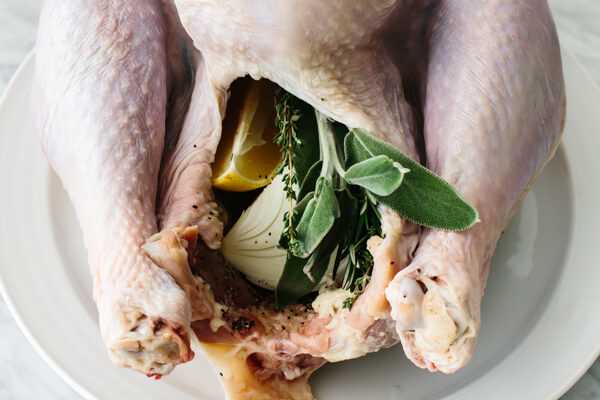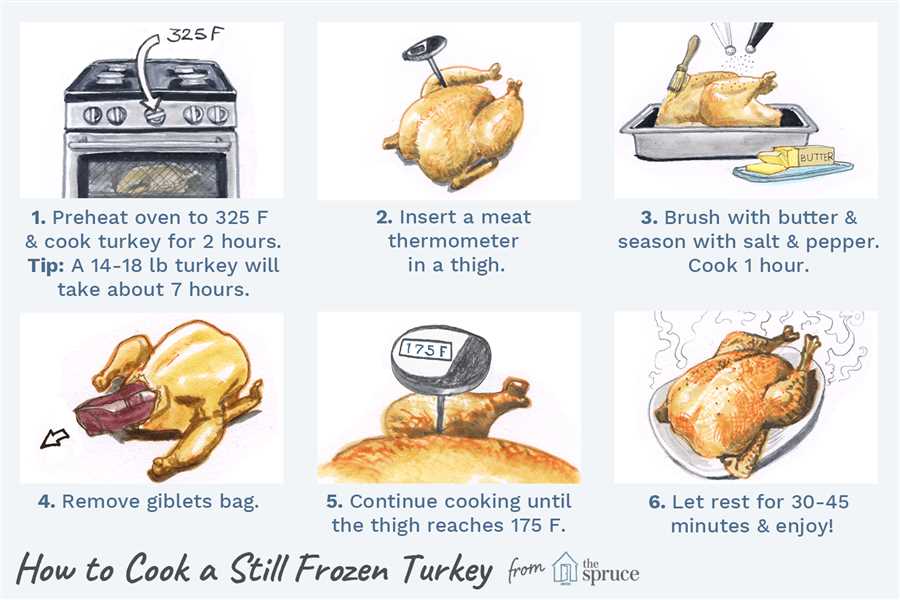





Thanksgiving is a time-honored holiday in the United States, and one of the traditional main dishes is a turkey roasted to perfection. Many people wonder if it is necessary to stuff the turkey before cooking, or if they can skip this step altogether. While stuffing a turkey is a popular practice, it is not the only way to prepare the bird for a delicious meal.
Cooking a turkey without stuffing has its advantages. One of the main benefits is that it reduces the cooking time. When you stuff a turkey, the cavity of the bird is filled with bread or rice stuffing, which can take longer to cook. By cooking the turkey without stuffing, you can ensure that the meat cooks evenly and is juicy throughout.
Another advantage of not stuffing a turkey is that it allows for more creativity in flavors and seasonings. When you cook the stuffing separately, you can experiment with different ingredients and spices to create a unique and flavorful side dish. This also gives you the opportunity to cater to different dietary restrictions or preferences, such as making a gluten-free stuffing or a vegetarian alternative.
However, if you still prefer the traditional way of cooking a turkey with stuffing, it is important to follow proper food safety guidelines. The stuffing and the turkey must reach an internal temperature of at least 165°F (74°C) to kill any harmful bacteria. It is crucial to ensure that the turkey is fully cooked, regardless of whether it is stuffed or not.
Cooking a Turkey Without Stuffing: Pros and Cons
When it comes to cooking a turkey, there are many different methods and techniques to consider. One question that often arises is whether or not to stuff the turkey. While stuffing can be a delicious addition to the meal, there are also some downsides to consider. In this article, we will explore the pros and cons of cooking a turkey without stuffing.
Pros of Cooking a Turkey Without Stuffing
1. Faster Cooking Time: One of the main advantages of cooking a turkey without stuffing is that it significantly reduces the cooking time. Without the stuffing, the turkey can cook more evenly and quickly, resulting in a shorter overall cooking time.
2. Crispy Skin: Another benefit of not stuffing the turkey is that it allows the skin to become crispy and golden brown. This is especially desirable for those who enjoy the texture and flavor of crispy turkey skin.
Cons of Cooking a Turkey Without Stuffing
1. Less Moist Meat: One potential drawback of not stuffing the turkey is that it can result in slightly drier meat. The stuffing helps to retain moisture and adds flavor to the meat as it cooks. Without the stuffing, the meat may be less flavorful and slightly less moist.
2. Missed Flavors: Stuffing can infuse the turkey with additional flavors, such as herbs, spices, and aromatics. Not stuffing the turkey means missing out on these added flavors within the meat.
Ultimately, the decision to cook a turkey with or without stuffing depends on personal preference and time constraints. If you prefer a faster cooking time and crispy skin, cooking the turkey without stuffing may be the best option for you. However, if you enjoy the added flavors and moistness that stuffing provides, you may want to consider cooking the turkey with stuffing. Either way, a delicious turkey can be achieved with careful preparation and cooking methods.
| Pros | Cons |
|---|---|
| Faster cooking time | Less moist meat |
| Crispy skin | Missed flavors |
Advantages of Cooking a Turkey Without Stuffing

When it comes to cooking a turkey, there are various methods that you can choose from. One popular option is to cook the turkey without stuffing it. While stuffing a turkey is a traditional method that many people enjoy, there are actually several advantages to cooking a turkey without stuffing.
1. Faster Cooking Time: Cooking a turkey without stuffing it allows for a faster cooking time. When you cook a turkey with stuffing, it requires additional time for the stuffing to reach the safe internal temperature. By cooking the turkey without stuffing, you can reduce the overall cooking time and have a delicious turkey ready to serve sooner.
2. Crispy Skin: Cooking a turkey without stuffing also helps to achieve a crispy, golden-brown skin. The hot air can circulate more effectively around the turkey, resulting in a perfectly crispy skin. This is especially appealing to those who prefer a crispy skin texture.
3. Even Cooking: Another advantage of cooking a turkey without stuffing is that it promotes even cooking. When you stuff a turkey, the stuffing can act as an insulator and prevent the heat from reaching the turkey evenly. Cooking the turkey without stuffing allows for better heat distribution, leading to evenly cooked meat throughout.
4. Food Safety: Removing the stuffing from the turkey also helps in ensuring food safety. Stuffing can absorb the juices and drippings from the turkey, which can increase the risk of bacterial contamination. By cooking the turkey without stuffing, you can reduce the chances of foodborne illnesses and ensure that your turkey is safe to eat.
5. Versatility: Lastly, cooking a turkey without stuffing provides more versatility. While traditional stuffing flavors can be delicious, cooking the turkey separately allows you to experiment with different seasonings and flavors. You can also prepare a variety of side dishes without worrying about the stuffing’s cooking time.
In conclusion, cooking a turkey without stuffing offers several advantages. It reduces cooking time, promotes a crispy skin, ensures even cooking, enhances food safety, and provides more culinary flexibility. Consider trying this method for your next turkey dinner and enjoy all the benefits it offers.
Disadvantages of Cooking a Turkey Without Stuffing

While cooking a turkey without stuffing may be a convenient option for some, there are several disadvantages to consider:
1. Lack of Flavor: One of the main disadvantages of cooking a turkey without stuffing is the potential lack of flavor. Stuffing enhances the taste of the turkey by absorbing its juices and spices. Without stuffing, the turkey may turn out to be less flavorful and moist.
2. Dryness: Another disadvantage is the increased likelihood of the turkey drying out during roasting. Stuffing not only adds flavor, but also helps keep the turkey moist by releasing moisture into the bird as it cooks. Without stuffing, there is a higher chance of the turkey becoming dry.
3. Reduced Cooking Time: Cooking a turkey without stuffing can actually result in a shorter cooking time, as the turkey is not weighed down by the added stuffing. However, this can also be a disadvantage if you prefer a slower-roasted turkey, as the shorter cooking time may result in a less tender bird.
4. Missed Texture and Aroma: Stuffing provides an additional element of texture and aroma to the turkey. It adds a moist and flavorful interior, along with a pleasant smell that fills the kitchen during cooking. Without stuffing, the turkey may lack these appealing qualities.
5. Lost Tradition: Cooking a turkey with stuffing is a long-standing tradition for many families. Without stuffing, you may miss out on the nostalgic experience of preparing and enjoying a classic turkey with stuffing.
In conclusion, while there may be some advantages to cooking a turkey without stuffing, such as shorter cooking time, there are also several disadvantages to consider. Lack of flavor, dryness, reduced cooking time, missed texture and aroma, and the loss of tradition are some of the drawbacks of opting for a stuffing-free turkey.
Alternative Options for Turkey Stuffing
While stuffing is a traditional and delicious addition to a Thanksgiving turkey, there may be occasions when you prefer to cook the turkey without it. Whether it’s due to dietary restrictions or personal preference, there are several alternative options for adding flavor and moisture to your turkey.
1. Herb Rub
One option is to create a flavorful herb rub to coat the turkey before roasting. Mix together a combination of herbs and spices such as sage, thyme, rosemary, garlic powder, salt, and pepper. Rub the mixture all over the turkey, including under the skin, to infuse it with flavor. Roast the turkey as usual, basting it with pan juices to keep it moist.
2. Citrus and Herb Infusion
Another option is to infuse the turkey with citrus and herbs. Slice lemons, oranges, or limes and stuff them inside the turkey cavity, along with sprigs of fresh herbs like rosemary and thyme. As the turkey roasts, the fruit and herbs will release their flavors, resulting in a moist and fragrant bird.
3. Vegetable Stuffing
If you’re avoiding traditional bread stuffing, consider using vegetables to stuff the turkey instead. Chop a mixture of vegetables such as onions, celery, carrots, and mushrooms, and sauté them in butter until tender. Season with herbs, salt, and pepper. Stuff the mixture inside the turkey cavity and roast as usual. The vegetables will add flavor and moisture to the bird.
4. Bacon Blanket
For a unique twist on stuffing, you can create a bacon blanket to cover the turkey. Lay strips of bacon over the turkey breast and thighs, securing them with toothpicks if necessary. As the bacon cooks, it will render its fat and infuse the turkey with a rich, smoky flavor. The bacon will also help to keep the meat moist.
These alternative options for turkey stuffing allow you to enjoy a flavorful and moist turkey without traditional stuffing. Experiment with different combinations of herbs, spices, and ingredients to find your favorite alternative stuffing method.
Questions and answers
Is it possible to cook a turkey without stuffing?
Yes, it is definitely possible to cook a turkey without stuffing. Many people prefer to cook their turkeys without stuffing to ensure that the bird cooks evenly and to avoid the potential risks of undercooked stuffing.
What are the advantages of cooking a turkey without stuffing?
There are a few advantages to cooking a turkey without stuffing. Firstly, cooking the bird without stuffing allows it to cook more evenly, as the heat can circulate freely around the meat. Secondly, there is no risk of the stuffing not reaching a safe temperature and causing foodborne illnesses. Lastly, cooking without stuffing allows you to season the turkey however you like, without the need to consider the taste of the stuffing.
Can I still add flavor to the turkey if I don’t stuff it?
Absolutely! Even without stuffing, there are various ways to add flavor to your turkey. You can season it with a dry rub or a marinade, or stuff the cavity with herbs, citrus fruits, or onions to infuse it with aromatic flavors. Basting the turkey with butter or broth throughout the cooking process also adds flavor.
How do I ensure that my turkey won’t dry out if I don’t stuff it?
To prevent your turkey from drying out when cooking it without stuffing, there are a few things you can do. Basting the turkey with butter or broth every 30 minutes helps to keep it moist. Additionally, you can cover the turkey with foil for the first portion of the cooking time to trap in moisture. Using a meat thermometer to monitor the internal temperature will also help prevent overcooking.










